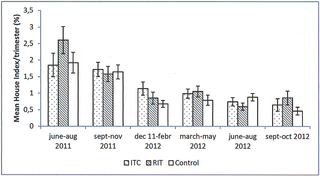PLOS Neglected Tropical Diseases ( IF 3.4 ) Pub Date : 2017-11-08 , DOI: 10.1371/journal.pntd.0006031 Maria Eugenia Toledo 1 , Veerle Vanlerberghe 2 , Julio Popa Rosales 3 , Mayelin Mirabal 4 , Pedro Cabrera 3 , Viviana Fonseca 3 , Tania Gómez Padrón 5 , Mirtha Pérez Menzies 3 , Domingo Montada 1 , Patrick Van der Stuyft 2, 6

|
Background
Aedes control interventions are considered the cornerstone of dengue control programmes, but there is scarce evidence on their effect on disease. We set-up a cluster randomized controlled trial in Santiago de Cuba to evaluate the entomological and epidemiological effectiveness of periodical intra- and peri-domiciliary residual insecticide (deltamethrin) treatment (RIT) and long lasting insecticide treated curtains (ITC).
Methodology/Principal findings
Sixty three clusters (around 250 households each) were randomly allocated to two intervention (RIT and ITC) and one control arm. Routine Aedes control activities (entomological surveillance, source reduction, selective adulticiding, health education) were applied in the whole study area. The outcome measures were clinical dengue case incidence and immature Aedes infestation. Effectiveness of tools was evaluated using a generalized linear regression model with a negative binomial link function.
Despite significant reduction in Aedes indices (Rate Ratio (RR) 0.54 (95%CI 0.32–0.89) in the first month after RIT, the effect faded out over time and dengue incidence was not reduced. Overall, in this setting there was no protective effect of RIT or ITC over routine in the 17months intervention period, with for house index RR of 1.16 (95%CI 0.96–1.40) and 1.25 (95%CI 1.03–1.50) and for dengue incidence 1.43 (95%CI 1.08–1.90) and RR of 0.96 (95%CI 0.72–1.28) respectively. The monthly dengue incidence rate (IR) at cluster level was best explained by epidemic periods (Incidence Rate Ratio (IRR) 5.50 (95%CI 4.14–7.31)), the IR in bordering houseblocks (IRR 1.03 (95%CI 1.02–1.04)) and the IR pre-intervention (IRR 1.02 (95%CI 1.00–1.04)).
Conclusions
Adding RIT to an intensive routine Aedes control programme has a transient effect on the already moderate low entomological infestation levels, while ITC did not have any effect. For both interventions, we didn’t evidence impact on disease incidence. Further studies are needed to evaluate impact in settings with high Aedes infestation and arbovirus case load.
中文翻译:

与古巴目前的最佳实践相比,滞留喷洒和杀虫剂处理的窗帘对登革热控制的额外好处:在低负担环境下进行强化常规控制的整群随机试验中评估发病率
背景
伊蚊控制干预措施被认为是登革热控制计划的基石,但很少有证据表明它们对疾病的影响。我们在古巴圣地亚哥开展了一项整群随机对照试验,以评估定期住所内和住所周围残留杀虫剂(溴氰菊酯)处理(RIT)和长效杀虫剂处理窗帘(ITC)的昆虫学和流行病学有效性。
方法/主要发现
63 个集群(每个集群约 250 个家庭)被随机分配给两个干预组(RIT 和 ITC)和一个对照组。整个研究区域均采用常规伊蚊控制活动(昆虫学监测、减少来源、选择性杀成虫、健康教育)。结果指标是临床登革热病例发生率和未成熟伊蚊感染。使用具有负二项式链接函数的广义线性回归模型评估工具的有效性。
尽管 RIT 后第一个月伊蚊指数显着降低(比率 (RR) 0.54 (95%CI 0.32–0.89)),但效果随着时间的推移逐渐消失,登革热发病率并未降低。总体而言,在这种情况下没有保护性措施在 17 个月的干预期内,RIT 或 ITC 相对于常规治疗的效果,房屋指数 RR 为 1.16 (95%CI 0.96–1.40) 和 1.25 (95%CI 1.03–1.50),登革热发病率为 1.43 (95%CI 1.08–1.90) ) 和 RR 分别为 0.96 (95%CI 0.72–1.28)。 集群水平的每月登革热发病率 (IR) 最好用流行时期来解释 (发病率比 (IRR) 5.50 (95%CI 4.14–7.31)),毗邻住宅区的 IR (IRR 1.03 (95% CI 1.02–1.04)) 和 IR 预干预 (IRR 1.02 (95% CI 1.00–1.04))。
结论
在强化常规伊蚊控制计划中添加 RIT 对已经中等偏低的昆虫感染水平具有短暂的影响,而 ITC 则没有任何效果。对于这两种干预措施,我们没有证据表明对疾病发生率有影响。需要进一步研究来评估伊蚊感染和虫媒病毒病例数高的环境中的影响。











































 京公网安备 11010802027423号
京公网安备 11010802027423号